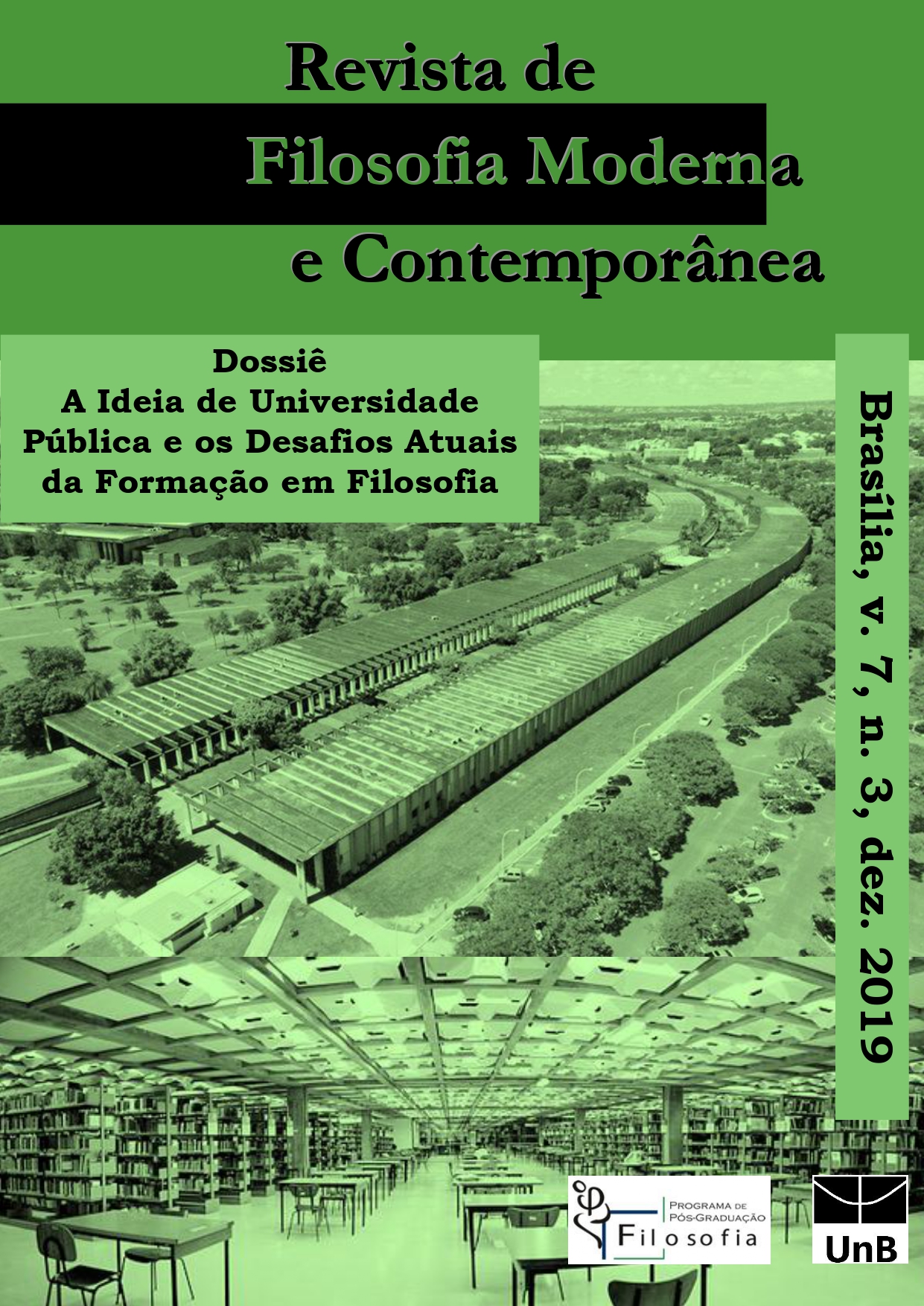Creativity and Existential Graphs in C. S. Peirce
DOI:
https://doi.org/10.26512/rfmc.v7i3.28453Keywords:
diagrammatical logic; deduction; creativity; Charles S. Peirce; existential graphsAbstract
Deductive reasoning is usually understood as analytical and explanatory, in the sense that it adds nothing to the conclusion that is not already contained in the premises of the argument. However, two important conclusions of Charles S. Peirce’s philosophy of logic challenge the supposed triviality of deductive reasoning: (i) deduction is a matter of experiment and observation; and (ii) deduction is a kind of diagrammatic reasoning. The aim of this paper is to show how these two conclusions are interconnected and how together they can elucidate some creative aspects of logic. To this end, the following theses will be discussed. First, deductive proof includes a creative step (Peirce calls it theorematic deduction) which explains how analytical reasoning can be, in some cases, surprising in its conclusions. Second, formal systems that include diagrammatic representations, such as Existential Graphs, are more efficient to represent deductive inferences of the theorematic type.
Downloads
References
ANDERSON, Douglas R. Creativity and the philosophy of C. S. Peirce. Martinus Nijhoff Publishers: Dordrecht, 1987.
CAMPOS, Daniel G. The imagination and hyphotesis-making in mathematics: a peircean account. In: New essays on Peirce’s Mathematical Philosophy. MOORE, Matthew E. (ed.). Chicago and La Salle, Illinois: Open Court, 2010. p. 123-145.
EUCLIDES. Os elementos. Trad. e introd. Irineu Bicudo. São Paulo: UNESP, 2009.
FREGE, Gottlob (1879). Preface. In: Begriffsschrift, a formula language, modeled upon that of arithmetic, for pure thought. In: HEIJENOORT, Jean van. From Frege to Gödel: a source book in Mathematical Logic, 1879-1931. Cambridge, Mass.; London, England: Harvard University Press, 1967. p. 5-8.
HINTIKKA, Jaakko. Information, deduction, and the a priori. In: Logic, language-games and information. Kantian themes in the Philosophy of Logic. Oxford: Clarendon Press, 1973. p. 222-241.
______. C.S. Peirce “first real discovery” and its contemporary relevance. In: The relevance of Charles Peirce. FREEMAN, Eugene (ed.). La Salle, Illinois: The Hegeler Institute/ Monist Library of Philosophy, 1983. p. 107-118.
______. On creativity in reasoning. In: ANDERSSON, Ake E. and SAHLIN, Nils-Eric (eds.). The complexity of creativity. Dordrecht: Kluwer Academic Publishers, 1997. p. 67-78.
HOFFMAN, Michael. Peirce's "diagrammatic reasoning" as a solution of the learning paradox. In: Process pragmatism: essays on a quiet philosophical revolution. DEBROCK, Guy (ed.). Amsterdam/ New York: Rodopi B.V., 2003. p. 121-143.
______. “Theoric transformations” and a new classification of abductive inferences. Transactions of the Charles S. Peirce Society: a quarterly journal in American Philosophy, v. 46, n. 4, p. 570-590, 2010.
KETNER, Kenneth Laine. How Hintikka misunderstood Peirce’s account of theorematic reasoning. Transactions of the Charles Peirce Society: a quarterly journal in American Philosophy, vol. XXI, n. 3, p. 407-418, 1985.
LEVY, Stephen H. Peirce’s theoremic/ corollarial distinction and the interconnections between mathematics and logic. In: Studies in the logic of Charles Sanders Peirce. HOUSER, Nathan; ROBERTS, Don D.; and EVRA, James Van (eds.). Indianapolis: Indiana University Press, 1997, p. 85-110.
LISZKA, James Jakób. A general introduction to the semeiotic of Charles Sanders Peirce. Bloomington and Indianapolis: Indiana University Press, 1996.
PEIRCE, Charles Sanders. Collected Papers. 8 vols. HARTSHORNE, Charles; HEISS, Paul and BURKS, Arthur (eds.). Cambridge: Harvard University Press, 1931-1958. [Citado como CP, seguido do número do volume e do número do parágrafo.]
______. Essential Peirce. HOUSER, Nathan; KLOESEL, Christian (eds.). Vol. 1 (1867-1893). Bloomington: Indiana University Press, 1992. [Citado como EP 1, seguido do número da página.]
______. Essential Peirce. The PEIRCE Edition Project (eds.). Vol. 2 (1893-1913). Bloomington: Indiana University Press, 1998. [Citado como EP 1, seguido do número da página.]
______. Pragmatism as a principle and method of right thinking: the 1903 Harvard lectures on pragmatism. TURRISI, Patricia Ann (ed.). New York: State University of New York Press, 1997. [Citado como HLP, seguido do número da página.]
______. The new elements of mathematics by Charles S. Peirce. 4 vols. EISELE, Carolyn (ed.). Bloomington: Indiana University Press, 1976. [Citado como NEM seguido do volume e número da página.]
______. Philosophy of Mathematics: selected writings. MOORE, Matthew E. (ed.). Indiana University Press: Bloomington and Indianapolis, 2010. [Citado como PM, seguido do número do parágrafo.]
PIETARINEN, Ahti-Veikko & BELLUCCI, Francesco. New light on Peirce's conceptions of retroduction, deduction, and scientific reasoning. International Studies in the Philosophy of Science, v. 28, n. 4, p. 353-373, 2014.
______. The iconic moment. towards a peircean theory of diagrammatic imagination. In: REDMOND, Juan, MARTINS, Olga P.; NEPOMUCENO, Ángel F. (eds). Epistemology, knowledge and the impact of interaction. Switzerland: Springer International Publishing, 2016. p 463-481.
RODRIGUES, Cassiano Terra. The method of scientific discovery in Peirce’s Philosophy: deduction, induction, and abduction. Logica Universalis, v. 5, p. 127-164, 2011
SHIN, Sun-Joo. The iconic logic of Peirce’s Graphs. Cambridge, Mass; London, England: The MIT Press, 2002.
______. The mystery of deduction and diagrammatic aspects of representation. Review of Philosophy and Psychology, v. 6, n. 1, p. 49-67, 2015.
______. The role of diagrams in abductive reasoning. In: KRAMER, Sybille and LJUNGBERG, Christina (Eds.). Thinking with Diagrams. Mouton: De Gruyter, 2016. p. 57-76.
______, LEMON, Oliver and MUMMA, John, Diagrams. In: ZALTA, Edward N. (ed.). The Stanford Encyclopedia of Philosophy. Winter, 2018. Available in: <https://plato.stanford.edu/archives/win2018/entries/diagrams/>.
STJERNFELT, Frederik. Natural propositions: the actuality of Peirce’s doctrine of dicisigns. Boston, Mass.: Docent Press, 2014.
SUPPES, Patrick. Introduction to logic. New York: Van Nostrand Reinhold Company, 1957.
ROBERTS, Don. The Existential Graphs of Charles S. Peirce. Mouton: The Hague, 1973.
SOWA, John F. Peirce’s tutorial on existential graphs, Semiotica, n. 186, p. 345-394, 2011.
ZEMAN, J. Jay. The graphical logic of Charles S. Peirce. PhD. Dissertation. Department of Philosophy: University of Chicago, 1964.
Downloads
Published
How to Cite
Issue
Section
License
Copyright for articles published in this journal is retained by the authors, with first publication rights granted to the journal. By virtue of their appearance in this open access journal, articles are free to use, with proper attribution, in educational and other non-commercial settings.


